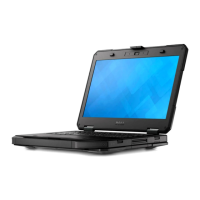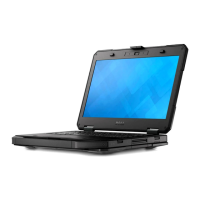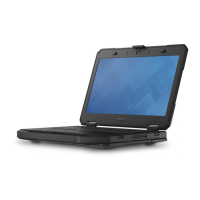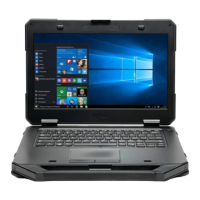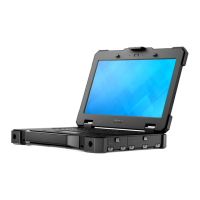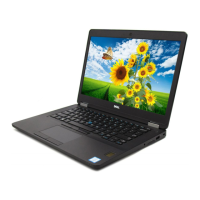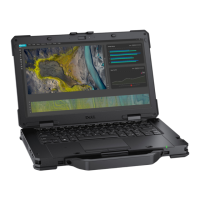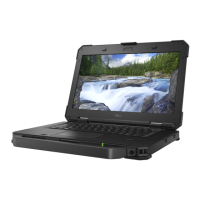
Do you have a question about the Dell Latitude 14 Rugged 5414 Series and is the answer not in the manual?
| Processor | Intel Core i5 |
|---|---|
| Display | 14.0" HD (1366 x 768) or FHD (1920 x 1080) |
| Memory | Up to 32GB DDR4 |
| Storage | Up to 512GB SSD |
| Graphics | Intel HD Graphics 520 |
| Operating System | Windows 10 Pro |
| Durability | MIL-STD-810G tested |
| Wireless | Intel Dual Band Wireless-AC 8260 |
| Ports | Ethernet, HDMI, SD card reader |
| Dimensions | 347 x 243 x 44.4 mm |
| Battery | 6-cell (65Wh) lithium-ion battery |
Guidelines to protect your computer from potential damage and ensure personal safety.
Steps to take before performing internal computer operations.
Procedures for shutting down the computer in different OS versions.
Steps to reconnect external devices after internal work.
Identifies key external components of the laptop through diagrams.
Lists essential tools required for component removal and installation.
Instructions for opening, closing, removing, and installing press latch doors.
Procedures for removing and installing the stylus and its tether.
Information about hot-swap and non-hot-swappable batteries.
Steps to safely remove the system battery.
Steps to safely install the system battery.
Introduction to hard drive removal and installation.
Detailed steps for removing the hard drive.
Detailed steps for installing the hard drive.
Procedures for removing and installing the optical drive.
Steps to remove the optical drive.
Steps to install the optical drive.
Instructions for removing and installing the base cover.
Steps to install the base cover.
Procedures for removing and installing the optical drive connector.
Steps to remove the optical drive connector.
Steps to install the optical drive connector.
Procedures for removing and installing the hard drive tray.
Steps to remove the hard drive tray.
Steps to install the hard drive tray.
Procedures for removing and installing the smart card module.
Steps to remove the smart card board.
Steps to install the smart card board.
Instructions for removing and installing the keyboard.
Steps to remove the keyboard.
Steps to install the keyboard.
Procedures for removing and installing memory modules.
Steps to remove a memory module.
Steps to install a memory module.
Procedures for removing and installing the docking board.
Steps to remove the docking board.
Steps to install the docking board.
Procedures for removing and installing the GPU board.
Steps to remove the GPU board.
Steps to install the GPU board.
Procedures for removing and installing the SIM module.
Steps to remove the SIM module.
Steps to install the SIM module.
Procedures for removing and installing the WLAN card.
Steps to remove the WLAN card.
Steps to install the WLAN card.
Procedures for removing and installing the WWAN card.
Steps to remove the WWAN card.
Steps to install the WWAN card.
Procedures for removing and installing the GPS board.
Steps to remove the GPS board.
Steps to install the GPS board.
Procedures for removing and installing the heat sink.
Steps to remove the heat sink.
Steps to install the heat sink.
Procedures for removing and installing the system fan.
Steps to remove the system fan.
Steps to install the system fan.
Procedures for removing and installing the RF cable holder.
Steps to remove the RF cable holder.
Steps to install the RF cable holder.
Procedures for removing and installing the display assembly.
Steps to remove the display assembly.
Steps to install the display assembly.
Procedures for removing and installing the display panel.
Steps to remove the display from the assembly.
Steps to install the display into the assembly.
Procedures for removing and installing the I/O board.
Steps to remove the I/O board.
Steps to install the I/O board.
Procedures for removing and installing the coin cell battery.
Steps to remove the coin cell battery.
Steps to install the coin cell battery.
Procedures for removing and installing the driving board.
Steps to remove the driving board.
Steps to install the driving board.
Procedures for removing and installing the battery connector.
Steps to remove the battery connector.
Steps to install the battery connector.
Procedures for removing and installing the system board.
Steps to remove the system board.
Steps to install the system board.
Steps to remove the power connector.
Steps to install the power connector.
Information about the front-facing camera resolution.
Steps to find camera in Win 10 Device Manager.
Steps to find camera in Win 8 Device Manager.
Steps to find camera in Win 7 Device Manager.
How to start the camera application.
Steps to launch the camera app.
Comprehensive hardware testing using embedded system diagnostics.
Explains the meaning of various device status indicator lights.
Explains the meaning of battery status indicator lights.
How to customize keyboard backlight colors and brightness.
Steps to control keyboard backlight brightness.
Method to cycle through backlight colors.
Explanation of the Fn key lock capability and its use.
How to enable or disable the Fn lock.
How to enable and disable stealth mode for covert operations.
Information about the 65 W and 90 W power adapters.
Details on the Intel 7th generation processors used.
Steps to identify processor details in Windows 10 Device Manager.
Steps to identify processor details in Windows 8 Device Manager.
Steps to identify processor details in Windows 7 Device Manager.
How to check processor usage via Task Manager.
How to check processor usage via Resource Monitor.
Information about the Intel Mobile CM238 chipset.
Steps to download and install chipset drivers.
Steps to find chipset in Win 10 Device Manager.
Steps to find chipset in Win 8 Device Manager.
Steps to find chipset in Win 7 Device Manager.
Information about the Intel HD Graphics 520 chipset.
Verifying installation of Intel HD Graphics drivers.
Information about screen resolutions and display features.
Steps to identify the display adapter in Device Manager.
Methods to rotate the display orientation.
Steps to download and install system drivers.
How to change the display resolution.
Steps to adjust screen brightness in Windows 10.
Steps to adjust screen brightness in Windows 8.
Steps to adjust screen brightness in Windows 7.
Instructions for safely cleaning the display screen.
Steps to connect to external monitors.
How to enable/disable the touch screen.
Information about supported hard drive types.
Steps to identify hard drive in Win 10 Device Manager.
Steps to identify hard drive in Win 8 Device Manager.
Steps to identify hard drive in Win 7 Device Manager.
How to view hard drive information in BIOS.
Information about the front-facing camera resolution.
Steps to find camera in Win 10 Device Manager.
Steps to find camera in Win 8 Device Manager.
Steps to find camera in Win 7 Device Manager.
How to start the camera application.
Steps to launch the camera app.
Information about supported memory types and speeds.
Steps to check memory in Win 10.
Steps to check memory in Win 8.
Steps to check memory in Win 7.
How to check memory in BIOS.
How to test memory using ePSA diagnostics.
Verifying installation of Realtek HD audio drivers.
How to bypass setup and boot directly to a device.
Explains keys used for navigating System Setup options.
General capabilities and recommendations for using System Setup.
Details about system information, battery, and device configurations.
Configuration options for integrated devices and ports.
Options related to display brightness and video settings.
Options for setting system and hard drive passwords.
Allows setting, changing, or deleting the system password.
Allows setting, changing, or deleting the hard drive password.
Enforces the use of strong passwords.
Sets minimum and maximum password lengths.
Allows or prevents password bypass.
Enables/disables changing admin passwords.
Controls setup changes when admin password is set.
Controls BIOS updates via UEFI packages.
Enables Trusted Platform Module (TPM) security.
Activates or deactivates optional Computrace software.
Enables or disables the processor's Execute Disable feature.
Creates additional preboot delay.
Options for Intel Virtualization Technology.
Options for viewing service tag and asset tag.
Options for viewing BIOS, thermal, and power events.
Recommended steps for updating BIOS via Windows.
Information and procedures for system and setup passwords.
Steps to assign a new system or admin password.
Steps to delete or change system/setup passwords.
Details on DRAM, Flash EPROM, and PCIe bus.
Information on processor types, cache, and frequency.
Details on memory connector, capacity, type, and speed.
Information on battery type, dimensions, voltage, and life span.
Details on audio type, controller, and stereo conversion.
Information on integrated and discrete graphics.
Details on network adapter and wireless capabilities.
Lists available audio, video, network, serial, USB, and SIM ports.
Technical details about the WLED display.
Dimensions of the touchpad's active area.
Details on number of keys and layout for different languages.
Information on power adapter type and input voltage.
Dimensions and weight of the computer.
Operating and storage conditions for the computer.
Troubleshooting steps for battery charging problems.
Steps to troubleshoot when the system does not power on.
Steps to troubleshoot display problems.
Troubleshooting incorrect BIOS settings.
Troubleshooting touchpad and keyboard related problems.
Steps to troubleshoot network port connectivity.
Troubleshooting external monitor connectivity and display.
